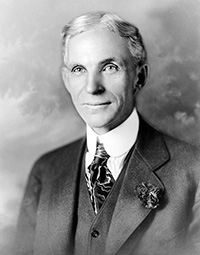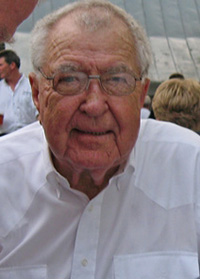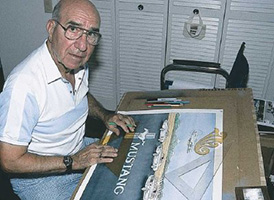 Born on July 30, 1863, near Dearborn, Michigan, Henry Ford created the Ford Model T car in 1908 and went on to develop the assembly line mode of production, which revolutionized the industry. As a result, Ford sold millions of cars and became a world-famous company head. The company lost its market dominance but had a lasting impact on other technological development and U.S. infrastructure.
Early Life
Famed automobile manufacturer Henry Ford was born on July 30, 1863, on his family's farm in Wayne County, near Dearborn, Michigan. When Ford was 13 years old, his father gifted him a pocket watch, which the young boy promptly took apart and reassembled. Friends and neighbors were impressed, and requested that he fix their timepieces too.Unsatistfied with farm work, Ford left home the following year, at the age of 16, to take an apprenticeship as a machinist in Detroit. In the years that followed, he would learn to skillfully operate and service steam engines, and would also study bookkeeping.
Early Career
In 1888, Ford married Clara Ala Bryant and briefly returned to farming to support his wife and son, Edsel. But three years later, he was hired as an engineer for the Edison Illuminating Company. In 1893, his natural talents earned him a promotion to chief engineer.
All the while, Ford developed his plans for a horseless carriage, and in 1896, he constructed his first model, the Ford Quadricycle. Within the same year, he attended a meeting with Edison executives and found himself presenting his automobile plans to Thomas Edison. The lighting genius encouraged Ford to build a second, better model.
Ford Motor Company
After a few trials building cars and companies, in 1903, Henry Ford established the Ford Motor Company. Ford introduced the Model T in October of 1908, and for several years, the company posted 100 percent gains.
However, more than for his profits, Ford became renowned for his revolutionary vision: the manufacture of an inexpensive automobile made by skilled workers who earn steady wages.
In 1914, he sponsored the development of the moving assembly line technique of mass production. Simultaneously, he introduced the $5-per-day wage ($110 in 2011) as a method of keeping the best workers loyal to his company. Simple to drive and cheap to repair, half of all cars in America in 1918 were Model T's.
Born on July 30, 1863, near Dearborn, Michigan, Henry Ford created the Ford Model T car in 1908 and went on to develop the assembly line mode of production, which revolutionized the industry. As a result, Ford sold millions of cars and became a world-famous company head. The company lost its market dominance but had a lasting impact on other technological development and U.S. infrastructure.
Early Life
Famed automobile manufacturer Henry Ford was born on July 30, 1863, on his family's farm in Wayne County, near Dearborn, Michigan. When Ford was 13 years old, his father gifted him a pocket watch, which the young boy promptly took apart and reassembled. Friends and neighbors were impressed, and requested that he fix their timepieces too.Unsatistfied with farm work, Ford left home the following year, at the age of 16, to take an apprenticeship as a machinist in Detroit. In the years that followed, he would learn to skillfully operate and service steam engines, and would also study bookkeeping.
Early Career
In 1888, Ford married Clara Ala Bryant and briefly returned to farming to support his wife and son, Edsel. But three years later, he was hired as an engineer for the Edison Illuminating Company. In 1893, his natural talents earned him a promotion to chief engineer.
All the while, Ford developed his plans for a horseless carriage, and in 1896, he constructed his first model, the Ford Quadricycle. Within the same year, he attended a meeting with Edison executives and found himself presenting his automobile plans to Thomas Edison. The lighting genius encouraged Ford to build a second, better model.
Ford Motor Company
After a few trials building cars and companies, in 1903, Henry Ford established the Ford Motor Company. Ford introduced the Model T in October of 1908, and for several years, the company posted 100 percent gains.
However, more than for his profits, Ford became renowned for his revolutionary vision: the manufacture of an inexpensive automobile made by skilled workers who earn steady wages.
In 1914, he sponsored the development of the moving assembly line technique of mass production. Simultaneously, he introduced the $5-per-day wage ($110 in 2011) as a method of keeping the best workers loyal to his company. Simple to drive and cheap to repair, half of all cars in America in 1918 were Model T's.
 Carroll Hall Shelby (January 11, 1923 – May 10, 2012) was an American automotive designer, racing driver and entrepreneur. He was best known for his involvement with the AC Cobra and later the Mustang-based performance cars for Ford Motor Company known as Shelby Mustangs which he had done since 1965. His company, Shelby American Inc., founded in 1962, currently sells modified Ford vehicles, as well as performance parts
Shelby was born on January 11, 1923, in Leesburg, Texas, to Warren Hall Shelby, a rural mail carrier, and his wife, Eloise (Lawrence) Shelby. Shelby suffered heart valve leakage problems by age 7 and spent most of his childhood in bed. By age 14, Shelby's health improved and he was subsequently declared to have "outgrown" his health problems. Shelby's first wife was Jeanne Fields; they married on December 18, 1943. Their daughter Sharon Anne Shelby was born a year later on September 27, 1944. They had two more children — sons named Michael Hall (born November 2, 1946) and Patrick Bert (born October 23, 1947). Shelby and Fields later separated and divorced in February 1960.
Shelby dealt with health issues throughout his life. He took nitroglycerine pills when he was racing because of his heart. He had a heart transplant in 1990 and a kidney transplant in 1996.
Shelby died on May 10, 2012, at the age of 89. He had been suffering from a serious heart ailment for decades. Joe Conway, president of Carroll Shelby International, said that "we are all deeply saddened, and feel a tremendous sense of loss for Carroll's family, ourselves and the entire automotive industry. There has been no one like Carroll Shelby and never will be. However, we promised Carroll we would carry on, and he put the team, the products and the vision in place to do just that."
Another one of his legacies may well be when he said to the TV camera "Yesterday's History. Tomorrow's a Mystery. So live for today." It seemed to be his credit
After retiring from driving in October 1959 for health reasons, he opened a high-performance driving school and the Shelby-American company.
He obtained a license to import the AC Cobra (often known in the USA as the Shelby Cobra,) a successful British Sports racing car manufactured by AC Motors of England, which AC had designed at Shelby's request by fitting a Ford V8 to their popular AC Ace sports car in place of its standard AC six, Ford Zephyr or 2 liter Bristol engine. Shelby continued on to be influential with Ford manufactured cars, including the Daytona Coupe, GT40, the Mustang-based Shelby GT350 and Shelby GT500. After parting with Ford, Shelby moved on to help develop performance cars with divisions of the two other Big 3 American companies, Dodge, and Oldsmobile.
Ford provided financial support for AC's Cobras from 1962 through 1965 and provided financial support for the Ford GTs, first with John Wyer's Ford Advanced Vehicles in 1963 and then with Shelby American from 1964 through 1967.
In the intervening years, Shelby had a series of ventures start and stop relating to production of "completion" Cobras — cars that were allegedly built using "left over" parts and frames. In the 1960s, the FIA required entrants (Shelby, Ford, Ferrari, etc.) to produce at least 100 cars for homologated classes of racing. Shelby simply ordered an insufficient number of cars and skipped a large block of Vehicle Identification Numbers, to create the illusion the company had imported large numbers of cars. Decades later in the 1990s, Carroll alleged that he had found the "left over" frames, and began selling cars which were supposedly finally "completed". After it was discovered the cars were built from scratch in collaboration with McCluskey, Ltd., they were re-termed "continuation" Cobras. The cars are still built to this day, known as the current CSX4000 series of Cobras.
He was inducted into the International Motorsports Hall of Fame in 1991, and theMotorsports Hall of Fame of America in 1992. He was inducted into the SCCA Hall of Fame on March 2, 2013.
In 2003, Ford Motor Co. and Carroll Shelby mended ties and he became technical advisor to the Ford GT project. In that same year, he formed Carroll Shelby International, Inc., based in Nevada.
Carroll Hall Shelby (January 11, 1923 – May 10, 2012) was an American automotive designer, racing driver and entrepreneur. He was best known for his involvement with the AC Cobra and later the Mustang-based performance cars for Ford Motor Company known as Shelby Mustangs which he had done since 1965. His company, Shelby American Inc., founded in 1962, currently sells modified Ford vehicles, as well as performance parts
Shelby was born on January 11, 1923, in Leesburg, Texas, to Warren Hall Shelby, a rural mail carrier, and his wife, Eloise (Lawrence) Shelby. Shelby suffered heart valve leakage problems by age 7 and spent most of his childhood in bed. By age 14, Shelby's health improved and he was subsequently declared to have "outgrown" his health problems. Shelby's first wife was Jeanne Fields; they married on December 18, 1943. Their daughter Sharon Anne Shelby was born a year later on September 27, 1944. They had two more children — sons named Michael Hall (born November 2, 1946) and Patrick Bert (born October 23, 1947). Shelby and Fields later separated and divorced in February 1960.
Shelby dealt with health issues throughout his life. He took nitroglycerine pills when he was racing because of his heart. He had a heart transplant in 1990 and a kidney transplant in 1996.
Shelby died on May 10, 2012, at the age of 89. He had been suffering from a serious heart ailment for decades. Joe Conway, president of Carroll Shelby International, said that "we are all deeply saddened, and feel a tremendous sense of loss for Carroll's family, ourselves and the entire automotive industry. There has been no one like Carroll Shelby and never will be. However, we promised Carroll we would carry on, and he put the team, the products and the vision in place to do just that."
Another one of his legacies may well be when he said to the TV camera "Yesterday's History. Tomorrow's a Mystery. So live for today." It seemed to be his credit
After retiring from driving in October 1959 for health reasons, he opened a high-performance driving school and the Shelby-American company.
He obtained a license to import the AC Cobra (often known in the USA as the Shelby Cobra,) a successful British Sports racing car manufactured by AC Motors of England, which AC had designed at Shelby's request by fitting a Ford V8 to their popular AC Ace sports car in place of its standard AC six, Ford Zephyr or 2 liter Bristol engine. Shelby continued on to be influential with Ford manufactured cars, including the Daytona Coupe, GT40, the Mustang-based Shelby GT350 and Shelby GT500. After parting with Ford, Shelby moved on to help develop performance cars with divisions of the two other Big 3 American companies, Dodge, and Oldsmobile.
Ford provided financial support for AC's Cobras from 1962 through 1965 and provided financial support for the Ford GTs, first with John Wyer's Ford Advanced Vehicles in 1963 and then with Shelby American from 1964 through 1967.
In the intervening years, Shelby had a series of ventures start and stop relating to production of "completion" Cobras — cars that were allegedly built using "left over" parts and frames. In the 1960s, the FIA required entrants (Shelby, Ford, Ferrari, etc.) to produce at least 100 cars for homologated classes of racing. Shelby simply ordered an insufficient number of cars and skipped a large block of Vehicle Identification Numbers, to create the illusion the company had imported large numbers of cars. Decades later in the 1990s, Carroll alleged that he had found the "left over" frames, and began selling cars which were supposedly finally "completed". After it was discovered the cars were built from scratch in collaboration with McCluskey, Ltd., they were re-termed "continuation" Cobras. The cars are still built to this day, known as the current CSX4000 series of Cobras.
He was inducted into the International Motorsports Hall of Fame in 1991, and theMotorsports Hall of Fame of America in 1992. He was inducted into the SCCA Hall of Fame on March 2, 2013.
In 2003, Ford Motor Co. and Carroll Shelby mended ties and he became technical advisor to the Ford GT project. In that same year, he formed Carroll Shelby International, Inc., based in Nevada.
 John Najjar Ferzely known as John Najjar (Nov. 11, 1918; Jan. 6, 2011), was a lead designer and executive stylist at Ford Motor Company for over 40 years. He is credited for having co-designed the first prototype of the Ford Mustang known asFord Mustang I with Philip T. Clark.
John Najjar was born to a working-class Greek Orthodox Christian Lebanese family in Omaha, Nebraska.[2] He joined Ford Motor Company's Apprentice School inDearborn, Michigan. While working there as a mere machinist, he was approached by Henry Ford during a plant tour who asked him if he enjoyed his work. John's response that he'd "rather be drawing cars" led to an invitation for him to add his talents to Ford's newly created Design Center.
He continued working as a designer for Ford for over 40 years. He worked with E. T. Gregorie, George Walker, Elwood Engel, Gene Bordinat and Lee Iacocca. For many years his work was centered on futuristic show cars whose revolutionary features later appeared in many Ford, Lincoln and Mercury vehicles.
John's Advanced Styling Studio developed the 1962 Ford Mustang I concept car - so named because of his love for its namesake, the P-51 Mustang fighter plane. His design talents span decades - from work on the M4A3 Sherman tank and B-24bomber in the 40s, the 1957-58 Lincoln Continentals, the XM-800, the soybean car, the LevaCar concept, the Gyron, Detroit's People Mover and Renaissance Center.
John Najjar also co-designed jointly with fellow Ford Motor Company stylist Bill Schmidt the groundbreaking Lincoln Futura, a futuristic concept car that served as a base for the Batmobile for the 1966 TV series Batman, as well as for the first movie adaptation of the Batman comics.
John Najjar Ferzely known as John Najjar (Nov. 11, 1918; Jan. 6, 2011), was a lead designer and executive stylist at Ford Motor Company for over 40 years. He is credited for having co-designed the first prototype of the Ford Mustang known asFord Mustang I with Philip T. Clark.
John Najjar was born to a working-class Greek Orthodox Christian Lebanese family in Omaha, Nebraska.[2] He joined Ford Motor Company's Apprentice School inDearborn, Michigan. While working there as a mere machinist, he was approached by Henry Ford during a plant tour who asked him if he enjoyed his work. John's response that he'd "rather be drawing cars" led to an invitation for him to add his talents to Ford's newly created Design Center.
He continued working as a designer for Ford for over 40 years. He worked with E. T. Gregorie, George Walker, Elwood Engel, Gene Bordinat and Lee Iacocca. For many years his work was centered on futuristic show cars whose revolutionary features later appeared in many Ford, Lincoln and Mercury vehicles.
John's Advanced Styling Studio developed the 1962 Ford Mustang I concept car - so named because of his love for its namesake, the P-51 Mustang fighter plane. His design talents span decades - from work on the M4A3 Sherman tank and B-24bomber in the 40s, the 1957-58 Lincoln Continentals, the XM-800, the soybean car, the LevaCar concept, the Gyron, Detroit's People Mover and Renaissance Center.
John Najjar also co-designed jointly with fellow Ford Motor Company stylist Bill Schmidt the groundbreaking Lincoln Futura, a futuristic concept car that served as a base for the Batmobile for the 1966 TV series Batman, as well as for the first movie adaptation of the Batman comics.







